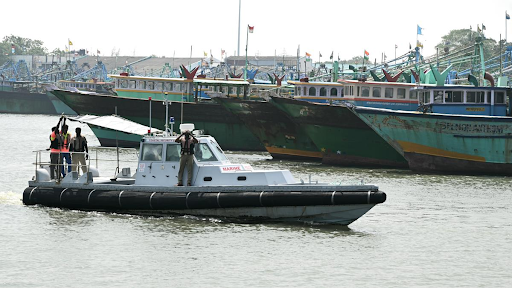Description

Source: TimesofIndia
Disclaimer: Copyright infringement not intended.
Context
- India is now all set to commission its second nuclear-powered submarine armed with nuclear missiles for strategic deterrence amid China’s fast-expanding naval footprint in the Indian Ocean Region.
Details
- INS Arighat is India's second indigenous nuclear-powered ballistic missile submarine (SSBN), following the successful commissioning of INS Arihant.
- It is a critical component of India's strategic nuclear deterrence capability, aimed at enhancing the country's second-strike capability in the event of a nuclear conflict.
- Once commissioned, it will join INS Arihant as part of India's strategic forces, contributing to the country's nuclear triad (land-based missiles, airborne nuclear weapons, and submarine-launched ballistic missiles).
Development and Construction
- INS Arighat was developed under the Advanced Technology Vessel (ATV) project and was constructed at the Shipbuilding Centre (SBC) in Visakhapatnam.
- The submarine is an upgraded variant of INS Arihant, with enhanced capabilities in terms of stealth, endurance, and firepower.
Specifications
- Displacement:Approximately 6,000-7,000 tonnes
- Length:Over 110 meters
- Propulsion:Pressurized water reactor (PWR), which allows for virtually unlimited underwater endurance
- Armament:
-
- Ballistic Missiles: Capable of carrying K-15 SLBMs (Submarine-Launched Ballistic Missiles) with a range of around 750 km, and potentially K-4 missiles with a range of 3,500 km.
- Torpedoes: Equipped with torpedoes and anti-ship missiles for self-defense.
Capabilities
- INS Arighat is designed to operate in deep waters and maintain high levels of stealth, making it difficult to detect by enemy submarines or anti-submarine warfare assets.
- Its nuclear propulsion provides it with the ability to remain submerged for extended periods, thereby enhancing its survivability and effectiveness as a strategic deterrent.
K-4 Submarine-Launched Ballistic Missile (SLBM)
- The K-4 missile is a crucial component of India's strategic deterrence capability, designed for deployment on the Indian Navy's nuclear-powered submarines.
- It is part of the larger K-series of missiles, which includes other submarine-launched ballistic missiles (SLBMs).
- Type: Submarine-Launched Ballistic Missile (SLBM)
- Range: Approximately 3,500 kilometers
- Development: Developed by the Defence Research and Development Organisation (DRDO) of India.
- Purpose: To provide second-strike capability, which is a key element of India's nuclear triad.
- Propulsion: Two-stage solid-fuel rocket, enhancing its range and speed.
- Accuracy: High accuracy due to its inertial guidance system with additional inputs from satellite navigation systems.
Design and Development
- Origins: The K-4 missile is part of India's "K Missile Family," named after Dr. A.P.J. Abdul Kalam, the former President of India and a prominent figure in the Indian missile program.
- Development History: The K-4 project is known for its high level of secrecy. Development began in the 1990s, and the first successful test was conducted in 2014.
SSBNs in India
- SSBNs are nuclear-powered submarines equipped with ballistic missiles. They form a crucial part of a nation's nuclear triad, ensuring a second-strike capability.
- Role in India's Defense Strategy: SSBNs provide India with a credible and survivable nuclear deterrent, capable of launching nuclear missiles from underwater, ensuring a secure second-strike capability.
Arihant-Class Submarines
- The Arihant class is India's first indigenous class of SSBNs, developed under the Advanced Technology Vessel (ATV) project.
- Development: The lead vessel, INS Arihant, was developed with assistance from Russia and has been operational since 2016.
- Specifications:
-
- Displacement: Around 6,000-7,000 tonnes.
- Propulsion: Powered by a pressurized water reactor developed by the Bhabha Atomic Research Centre (BARC).
- Armament: Equipped with K-15 (Sagarika) and K-4 ballistic missiles, capable of carrying nuclear warheads.
Future Developments
- INS Aridhaman (S4) and S4:
-
- Status: Launched in November 2021, these are advanced versions of the Arihant-class submarines with greater displacement and missile capacity.
- Specifications: Designed to carry 8 K-4 or K-5 missiles, making them significantly more capable.
- S5 Class (Arihant Follow-On):
-
- Future SSBNs: Plans are underway for the S5 class, which will be larger and more advanced than the Arihant class, with up to 12 missile launch tubes.
- Expected Commissioning: Likely to be operational in the early 2030s.
SSBNs (Ballistic Missile Submarines) Worldwide
|
Country
|
SSBN Class
|
Number of SSBNs
|
Missile System
|
Key Features
|
|
United States
|
Ohio-class
|
14
|
Trident II D5
|
24 SLBM tubes, advanced stealth, long operational range
|
|
Russia
|
Borei-class
|
11 (planned)
|
R-30 Bulava
|
Modern SLBMs, increased stealth, quieter propulsion
|
|
China
|
Jin-class (Type 094)
|
6
|
JL-2
|
Improved missile range, advanced sonar
|
|
France
|
Triomphant-class
|
4
|
M51 SLBM
|
Advanced SLBM with MIRV capability, enhanced stealth
|
|
United Kingdom
|
Vanguard-class
|
4
|
Trident II D5
|
SLBMs with multiple warheads, continuous at-sea deterrence
|
Must read article:
INS Arihant
Nuclear Triad
Sources:
TimesofIndia
|
PRACTICE QUESTION
Q: Consider the following statements regarding India's SSBN fleet:
- India currently operates one SSBN, INS Arihant, which was the first indigenously built nuclear-powered submarine.
- INS Arighat, another SSBN, is expected to join the fleet soon and is based on the same design as INS Arihant.
- India's SSBNs are primarily based on the Russian Akula-class design with significant indigenous modifications.
Which of the statements given above is/are correct?
a) 1 and 2 only
b) 2 and 3 only
c) 1 and 3 only
d) 1, 2, and 3
Answer: a)
|










